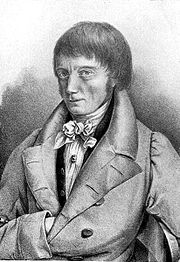
Theodor Friedrich Ludwig Nees von Esenbeck
Encyclopedia

Hyères
Hyères , Provençal Occitan: Ieras in classical norm or Iero in Mistralian norm) is a commune in the Var department in the Provence-Alpes-Côte d'Azur region in southeastern France....
) was a German botanist and pharmacologist who was a native of Schloss Reichenberg in Reichelsheim (Odenwald)
Reichelsheim (Odenwald)
Reichelsheim is a community in the Odenwaldkreis in Hesse, Germany.-Location:Reichelsheim lies in the middle Odenwald at elevations between 200 and 538 m in the middle of the Geo-Naturpark Bergstraße-Odenwald....
. He was a younger brother to naturalist
Naturalist
Naturalist may refer to:* Practitioner of natural history* Conservationist* Advocate of naturalism * Naturalist , autobiography-See also:* The American Naturalist, periodical* Naturalism...
Christian Gottfried Daniel Nees von Esenbeck
Christian Gottfried Daniel Nees von Esenbeck
Christian Gottfried Daniel Nees von Esenbeck was a prolific German botanist, physician, zoologist, and natural philosopher. He was a contemporary of Goethe and was born within the lifetime of Linnaeus. He described approximately 7,000 plant species...
(1776–1858).
In 1805 Nees von Esenbeck was an apprentice to pharmacist
Pharmacist
Pharmacists are allied health professionals who practice in pharmacy, the field of health sciences focusing on safe and effective medication use...
Wilhelm Martius in Erlangen
Erlangen
Erlangen is a Middle Franconian city in Bavaria, Germany. It is located at the confluence of the river Regnitz and its large tributary, the Untere Schwabach.Erlangen has more than 100,000 inhabitants....
, and in 1811 moved to Basel
Basel
Basel or Basle In the national languages of Switzerland the city is also known as Bâle , Basilea and Basilea is Switzerland's third most populous city with about 166,000 inhabitants. Located where the Swiss, French and German borders meet, Basel also has suburbs in France and Germany...
where he worked for the Bernoulli family at the Goldenen Apotheke. In 1817 his friend, zoologist Heinrich Kuhl
Heinrich Kuhl
Heinrich Kuhl was a German naturalist and zoologist.Kuhl was born in Hanau. He became assistant to Coenraad Jacob Temminck at the Leiden museum. In 1817 he published a monograph on bats and in 1819 he published Conspectus psittacorum...
(1797–1821) procured an assignment for him at the University of Leiden as a reader of botany, and shortly afterwards, with the help of botanist Sebald Justinus Brugmans
Sebald Justinus Brugmans
Sebald Justinus Brugmans was a Dutch botanist, physician and professor of natural sciences.Brugmans studied at the University of Groningen, where he earned doctorates in medicine and philosophy, and also a masters degree in liberal arts...
(1763–1819), he held a position at the Botanical Gardens in Leiden. In 1818 he earned his doctorate at the university, and subsequently moved to Bonn
Bonn
Bonn is the 19th largest city in Germany. Located in the Cologne/Bonn Region, about 25 kilometres south of Cologne on the river Rhine in the State of North Rhine-Westphalia, it was the capital of West Germany from 1949 to 1990 and the official seat of government of united Germany from 1990 to 1999....
where he worked at the Botanical Gardens. In 1827 he attained the title of "full professor" at the University of Bonn
University of Bonn
The University of Bonn is a public research university located in Bonn, Germany. Founded in its present form in 1818, as the linear successor of earlier academic institutions, the University of Bonn is today one of the leading universities in Germany. The University of Bonn offers a large number...
, where he was a colleague of Ludolph Christian Treviranus
Ludolph Christian Treviranus
Ludolph Christian Treviranus was a German botanist who was born in Bremen. He was a younger brother to naturalist Gottfried Reinhold Treviranus ....
(1779–1864).
Nees von Esenbeck is remembered for his systematic research concerning the medicinal properties of plants. In 1834 with Ludwig Clamor Marquart
Ludwig Clamor Marquart
Ludwig Clamor Marquart was a German pharmacist and entrepreneur who was a native of Osnabrück.As a teenager he was a pharmacist’s apprentice in the town of Dissen, and afterwards an assistant pharmacist in Lingen and Werden...
(1804–1881), Philipp Wilhelm Wirtgen
Philipp Wilhelm Wirtgen
Philipp Wilhelm Wirtgen was a German botanist and teacher who was a native of Neuwied.He was a school teacher in Remagen, Winningen and beginning in 1831 at Koblenz...
(1806–1870), Johann Carl Fuhlrott
Johann Carl Fuhlrott
Prof. Dr. Johann Carl Fuhlrott was born December 31, 1803 in Leinefelde, Germany, and died October 17, 1877 in Elberfeld, . He is famous for recognizing the significance of the bones of Neanderthal 1, a Neanderthal specimen discovered by German laborers who were digging for limestone in Neander...
(1803–1873) and his older brother, he founded a botanical organization that performed important investigations involving the botany of the Rhineland
Rhineland
Historically, the Rhinelands refers to a loosely-defined region embracing the land on either bank of the River Rhine in central Europe....
. The plant genus Neesia in the subfamily Bombacoideae
Bombacoideae
Bombacoideae is a subfamily of the mallow family, Malvaceae. It contains herbaceous and woody plants. Their leaves are alternate, commonly palmately lobed, with small and caducous stipules. Flowers are hermaphroditic and actinomorphic; the calyx has 5 sepals united at the base, accompanied...
was named after him by botanist Carl Ludwig Blume
Carl Ludwig Blume
Charles Ludwig de Blume or Karl Ludwig von Blume was a German-Dutch botanist.He was born at Braunschweig in Germany, but studied at Leiden University and spent his professional life working in the Dutch East Indies and in the Netherlands, where he was Director of the Rijksherbarium at Leiden...
(1796–1862).
Selected writings
- Plantae officinales, oder Sammlung officineller Pflanzen, Düsseldorf 1821-1833.
- Sammlung schön blühender Gewächse in lithographierten Abbildungen, für Blumen- und Gartenfreunde, Düsseldorf 1825-1831.
- Handbuch der medicinisch-pharmaceutischen Botanik, Düsseldorf 1830-1832.
- Plantae medicinales, Düsseldorf 1833
- Genera Plantarum Florae Germanicae, Bonn 1833-1838.
- Das System der Pilze, Bonn 1837.

